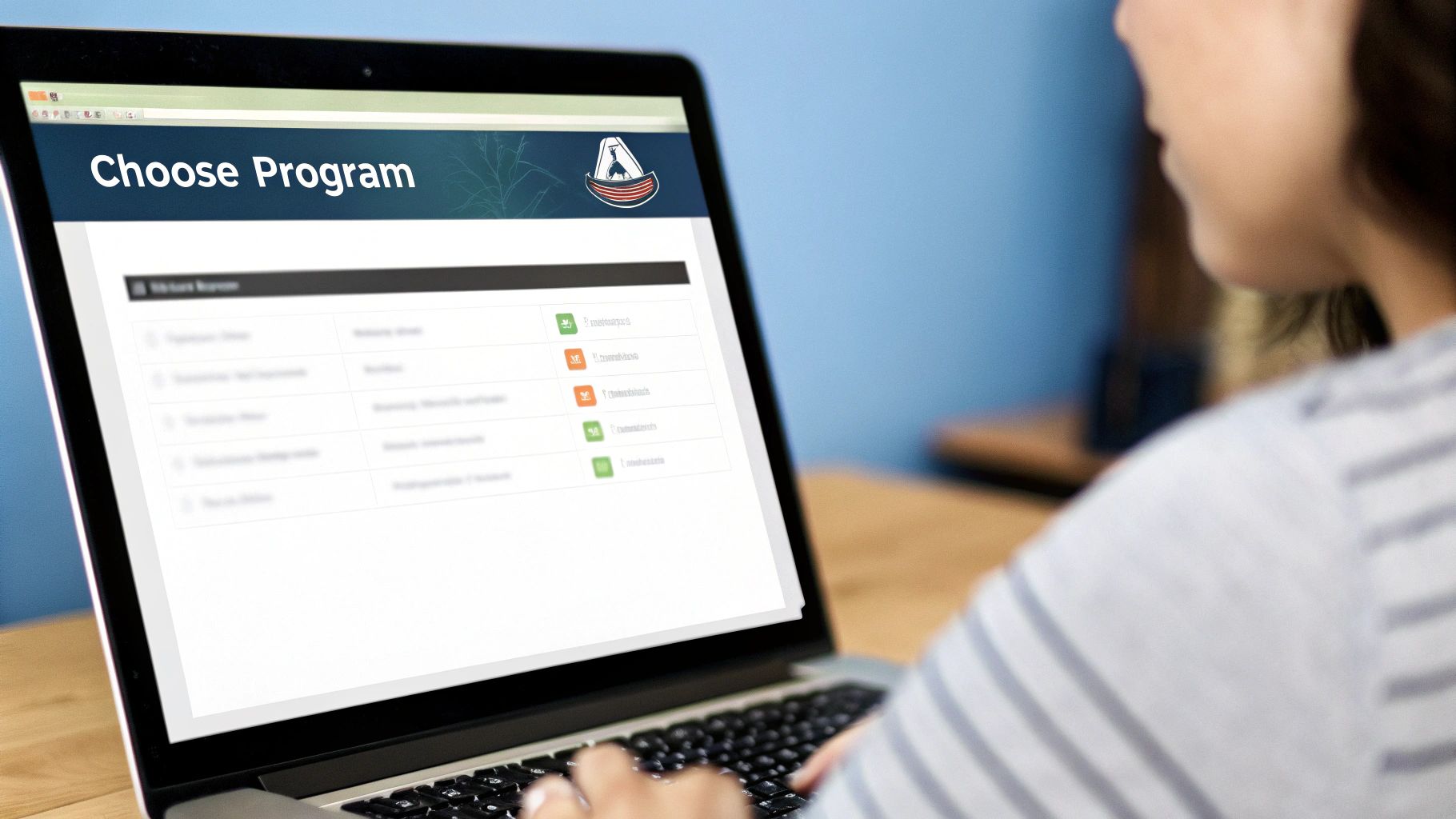Getting your first affiliate link is a lot easier than most people imagine. Essentially, you just join a company's affiliate program, and once you're approved, you can generate a unique URL right from their dashboard. This special link is tagged with your personal ID, making sure you get credit for every sale you send their way.
What Exactly Is an Affiliate Link and How Does It Work?

Before you start plastering links everywhere, it’s really important to get what they are and how they actually function. At its heart, an affiliate link is just a specific URL that has your unique affiliate ID or username baked into it.
When someone clicks that link, a tiny file—a cookie—gets saved to their web browser. This cookie acts like a digital name tag, telling the merchant, "Hey, this person came from [Your Name]'s website!"
This tracking system is the absolute core of affiliate marketing. If that visitor buys something within a set period (the "cookie duration"), the merchant's system spots your cookie and automatically credits your account with a commission. In technical terms, it's just an external link that points from your site to another, but with a special job to do.
The Anatomy of an Affiliate Link
Every affiliate link might look a bit different, but they all share a similar structure. Once you understand the parts, they stop looking like a random jumble of letters and numbers.
Let's break down what you're actually looking at when you see an affiliate link.
Table: Anatomy of an Affiliate Link
| Component | Example | Purpose |
|---|---|---|
| Base URL | https://www.exampleproduct.com/widget |
This is the standard webpage the customer will land on. |
| Tracking Parameter | ? or & |
The symbol that separates the base URL from the tracking data. |
| Affiliate ID | ref=yourname123 or affid=456 |
This is your unique identifier that tells the merchant you sent the traffic. |
Breaking it down like this makes it clear that the link is just a standard URL with your unique signature attached to the end.
Key Takeaway: The affiliate ID embedded in the URL is non-negotiable. It's the digital signature that proves a sale originated from your marketing efforts, ensuring you get paid for your referrals. Without it, you're just sending free traffic.
This simple but powerful system has created a massive industry. As of 2025, the global affiliate marketing space is valued at around $18.5 billion and shows no signs of slowing down. It's a performance-based model that just works, which is why giants like Amazon Associates dominate the market. Marketers share these links everywhere—blogs, social media, videos—because they are proven to drive sales and boost conversions.
Finding and Joining the Right Affiliate Programs

Before you even think about creating an affiliate link, you need a partner. Your entire success in affiliate marketing really boils down to this: choosing programs that your audience will actually care about and that make sense with your content. This isn't just about grabbing any old link; it's about building trust.
As you start looking, you’ll quickly find there are two main ways to go: joining a massive network or working directly with a brand.
- Affiliate Networks: These are the big marketplaces of the affiliate world, like ShareASale or CJ Affiliate. Think of them as a one-stop shop where thousands of merchants live under one roof. You get a huge variety of products and one dashboard to track everything.
- In-House Programs: Many companies, especially in the SaaS space, run their own programs. The upside here is often a more personal connection with the affiliate manager and sometimes even better commission rates since there’s no network taking a cut.
The market is huge. As you start to Explore various affiliate programs, your main goal is to find partners whose products you can get behind and recommend with confidence.
What to Look for in a Program
Let’s be honest: not all affiliate programs are created equal. When you're vetting potential partners, you have to dig into the terms and conditions. These details aren't just fine print; they directly dictate how much you can earn and what the experience will be like.
For example, understanding the commission structure is critical. In the software industry, recurring commissions are a total game-changer. Our guide to https://refgrow.com/blog/saas-affiliate-marketing breaks down how these models create a stable, predictable income, which is a world away from one-off payouts.
Here’s what I always zero in on:
- Commission Rate: Is it a percentage of the sale, a flat fee, or a recurring commission for subscription products?
- Cookie Duration: This is your tracking window. A 30-day cookie means if someone clicks your link and buys within 30 days, you get credit. Longer is almost always better.
- Payment Threshold: How much do you have to earn before they’ll actually pay you? A high threshold of $100 or more can be a real pain when you're just starting out.
- Payout Methods: Do they offer PayPal or direct deposit? Make sure their payment method works for you before you invest your time.
Pro Tip: Don't get mesmerized by a high commission rate. I’d much rather have a 10% commission on a product that converts like crazy than a 50% commission on something nobody wants to buy.
Red Flags to Avoid
Just as there are great programs, there are definitely some you should run from. Your reputation with your audience is everything, so you absolutely have to be selective.
I immediately get skeptical when I see a program with a string of bad reviews from other affiliates. That usually points to late payments or non-existent support. Vague or confusing terms of service are another deal-breaker—if I can't figure out exactly how and when I get paid, I'm out.
The good news is that you don't have to settle. The affiliate marketing world is bigger than ever, with U.S. spending projected to hit nearly $12 billion in 2025. More than 80% of advertisers now have affiliate programs and report an average ROI of $15 for every $1 spent. There are plenty of fantastic partners out there waiting for you.
Time to Create Your First Affiliate Link in Refgrow
Alright, enough with the theory. Let's get our hands dirty and actually generate your first affiliate link. I'll walk you through how to do this using a modern platform like Refgrow, showing you just how fast you can go from concept to a clickable, trackable URL.
When you first log into your affiliate account, you’ll land on the main dashboard. Think of this as your mission control—it's where you'll see your stats, find programs to join, and, most importantly, grab your links.

The first thing you need to do is decide which product or service you're actually going to promote. Once you've picked one, you're ready for the next step.
Finding Your Unique Affiliate URL
After you've selected a campaign or program, the platform will give you your unique affiliate link. This isn't just a random URL; it’s been generated specifically for you and contains your personal affiliate ID. That little piece of code is what makes sure you get credit for any sales.
In Refgrow, it’s usually as simple as finding the campaign and hitting a "Copy Link" button. That action saves the full URL to your clipboard, and it's ready to be pasted into your blog post, social media update, or email. The whole process is built for speed.
This ease of use is no accident. The affiliate marketing industry has exploded, with U.S. spending hitting $9.56 billion in 2023 and projected to reach a staggering $15.8 billion by 2028. You can dive deeper into these affiliate marketing spending trends on Statista.com. This growth is fueled by platforms that remove the old technical headaches, especially for high-ticket SaaS products where every click counts.
Take It a Step Further with Custom Links
Getting your basic affiliate link is a great start, but the real pros know that the money is in deep linking.
What's a deep link? Instead of sending your audience to a generic homepage, you direct them to a specific page—like a product page, a pricing table, or a detailed feature overview. This is a game-changer for conversions.
Think about it. If you write a glowing review of a specific software feature, it makes zero sense to send readers to the company's homepage and make them hunt for it. Link them directly to the page discussing that feature. You're removing friction and making it incredibly easy for them to take the next step.
My Personal Tip: Always, always create a deep link if the program allows it. Most good platforms have a "custom link generator." Just paste the exact destination URL you want to send people to, and it will append your affiliate ID. This tiny extra step shows your audience you respect their time and dramatically increases your chance of earning a commission.
Best Practices for Placing and Managing Your Links
Getting your link generated is just the first step. The real magic happens in where and how you place it. A fantastic affiliate link hidden in the wrong spot is like a Super Bowl ad that airs at 3 AM—it’s technically out there, but no one’s going to see it. Smart placement means weaving your links into your content so naturally that they feel like a helpful part of the conversation.
The best way I’ve found to do this is with contextual links. These are simply links embedded right into your content, tied to specific, relevant words. Instead of a generic "Click Here" button, you could write something like, "I switched to using [Brand X's tool] and it completely streamlined my workflow." See? It feels like a genuine tip, not a hard sell, which is exactly why it builds trust and gets more clicks.
Keep Your Links Clean and Trustworthy
Let’s be honest, long, clunky affiliate URLs crammed with tracking codes look a little sketchy. They can scare people away from clicking. This is where a technique called link cloaking comes in handy. It's essentially the practice of transforming that messy URL into something short, clean, and much more professional.
For instance, you can turn this:https://www.examplestore.com/product/widget?affid=user123&utm_source=blog
Into something much cleaner, like this:https://www.yourwebsite.com/recommends/widget
Not only does this look better, but it also helps protect your commissions from being stolen by sneaky browser extensions. Plus, it gives you a central place to manage all your links. Getting this right is a core part of building effective influencer marketing strategies that are built on authenticity.
Disclose Everything to Build Trust
In the world of affiliate marketing, transparency isn't just a nice-to-have; it's a must. The Federal Trade Commission (FTC) has clear rules requiring you to disclose that you might earn a commission from your links. Don’t try to bury this information in a dense footer or on some forgotten legal page.
Put a simple, clear disclaimer right at the top of your blog posts. Something like, "Heads up: This post may contain affiliate links. If you buy something through one of these links, I may earn a small commission at no extra cost to you," works perfectly. This kind of honesty doesn’t scare people off. In my experience, it actually builds credibility and strengthens the bond you have with your audience.
Key Insight: Your audience is savvy. They understand that creators need to earn a living. Being upfront about how you make money shows you respect them, and they'll often be more willing to support you because of it.
Smart Link Management Saves Time and Money
As your content library grows, you could easily end up with hundreds—or even thousands—of affiliate links spread across dozens of articles. Now, imagine a product is discontinued, a link breaks, or a partner changes its affiliate platform. Trying to hunt down and update every single link manually is an absolute nightmare.
This is precisely why a link management tool is a game-changer. Platforms like Refgrow, or even a good WordPress plugin, let you control all your affiliate links from one central dashboard. If a URL needs to be updated, you change it once in the dashboard, and it automatically populates across your entire site. Want to dive deeper into streamlining this? Our guide on how to manage an affiliate program is a great place to start. This proactive approach is the best way to protect your income from the slow death of broken links.
Tracking Performance and Optimizing for Better Results

Here’s a truth every top affiliate eventually learns: getting your link created is just the starting line. The real work—the part that separates a few bucks from a serious income stream—is all about tracking, analyzing, and constantly tweaking your approach. If you’re just setting and forgetting your links, you’re leaving money on the table.
Think of your affiliate dashboard as your mission control. It’s where you’ll find the raw data that tells a story about what your audience truly wants. Diving into those analytics is how you shift from guessing what might work to building a data-backed strategy that actively drives revenue.
Understanding Your Key Metrics
To make smart decisions, you need to know which numbers actually matter. It's easy to get overwhelmed by all the data, but focusing on a few core metrics will keep you on track.
You should be looking at these regularly:
- Clicks: This one’s simple—it's the total number of times people have clicked your links. It’s a good starting point, but on its own, it doesn't tell you much about your success.
- Conversion Rate: This is where things get interesting. It’s the percentage of clicks that turn into a sale or a sign-up. If your conversion rate is low, it’s a big red flag that your message might not be resonating with the product you're promoting.
- Earnings Per Click (EPC): EPC is one of my favorite metrics because it cuts right to the chase. It shows you exactly how much you earn, on average, every single time someone clicks one of your links. A high EPC is a clear sign you’ve found a winning combination of traffic, offer, and audience.
Let's break that down. Say you drive 100 clicks to a product and bank $50 in commissions. Your EPC is a solid $0.50. This simple number makes it incredibly easy to see which campaigns are actually making you money, even if they have completely different commission rates.
Pro Tip: Don't get fixated on raw click volume. A link that gets 20 clicks and 2 sales has a 10% conversion rate. That's far more impressive than another link with 200 clicks and only 1 sale (0.5% conversion rate). EPC cuts through the noise and shows you the true winner.
Key Metrics for Affiliate Link Tracking
To help you stay focused, this table breaks down the most important metrics you should be monitoring to optimize your affiliate marketing performance.
| Metric | What It Measures | Why It's Important |
|---|---|---|
| Clicks | The total number of times your affiliate link has been clicked. | Indicates initial interest and the effectiveness of your call-to-action. |
| Conversion Rate | The percentage of clicks that result in a sale or desired action. | Measures how well your audience connects with the product you're promoting. |
| Earnings Per Click (EPC) | The average revenue generated for each click on your affiliate link. | Quickly identifies your most profitable campaigns and content pieces. |
| Commission Amount | The total earnings generated from your referrals. | The ultimate measure of your campaign's financial success. |
| Reversal Rate | The percentage of commissions that are canceled due to returns or refunds. | A high rate can signal issues with the product or misleading promotion. |
Monitoring these metrics isn't just about checking boxes; it’s about understanding the story your data is telling so you can make smarter, more profitable decisions.
Practical Optimization and A/B Testing
Once you’ve got a handle on your numbers, it's time to put that knowledge into action. This is where you get to experiment and systematically improve your results. The goal is simple: find out what works best, then do more of it.
Start with some simple A/B tests. This just means you change one thing at a time to see how it impacts performance. For instance, you could test two different calls-to-action for the exact same affiliate link. Does "Get Started with [Product]" perform better than "Learn More About [Product]"? The data will tell you.
Link placement is another powerful variable to test. In one article, try weaving a link naturally into a sentence. In another, place it in a bold "Recommended Tools" box. Track the clicks and EPC for each to see what your audience responds to. This kind of hands-on testing is how you graduate from being a passive affiliate to one who actively shapes their own success.
As you dive into the world of affiliate marketing, you're bound to run into some questions. It's completely normal. Getting solid answers to these common queries can make all the difference, helping you move past roadblocks and feel more confident in your strategy.
Let's walk through some of the most frequent questions I hear from marketers, both new and experienced.
A big question right out of the gate is, "Can I create an affiliate link for any product I see online?" The simple answer is no. You can only generate links for products sold by companies whose affiliate program you've been accepted into. First, you have to apply and get their official green light.
Another point of confusion is often the cost. The good news? Joining affiliate programs and creating links is almost always completely free. Reputable companies won't charge you to become a partner. If a program ever asks you for an application fee or money upfront, that's a massive red flag. Steer clear.
Understanding Link Duration and Placement
Once you have your link, you'll naturally wonder how long it works. This is all about the "cookie duration" (sometimes called "cookie life"). It's the specific timeframe after someone clicks your link during which you’re eligible for a commission if they buy something.
This window can vary wildly from one program to the next.
- Short-Term: Amazon Associates is famous for its 24-hour cookie. It’s a tight window.
- Standard: A 30, 60, or 90-day duration is far more common and gives people more time to decide.
- Long-Term: Some of the most generous programs offer cookies that last 180 days or even longer.
Obviously, a longer cookie duration is a huge perk for you. It gives your audience plenty of time to consider a purchase without you losing the credit.
Finally, what about placement? Do you have to have a website? While a blog is the classic home for affiliate links, it's definitely not your only option. Many programs are quite flexible, allowing you to share links on social media, in email newsletters, on your YouTube channel, or even in podcast show notes. Just be sure to double-check each program's terms of service to see what they allow.
Key Takeaway: The "rules" of affiliate links—like cookie duration and where you can post them—are set by each individual program. Never assume one program's policies apply to another. Always read the terms to ensure you’re compliant and maximizing your earning potential.
Down the road, as your business scales, you might even decide to build your own affiliate program. When that time comes, our guide on how to recruit affiliates will give you a solid foundation for finding and attracting great partners.
Ready to stop relying on clunky, external affiliate dashboards and start building a seamless, in-app referral program? With Refgrow, you can launch a fully native and customizable affiliate experience for your SaaS product with just a single line of code. Join over 1,600 businesses and start scaling your growth today. Get started with Refgrow.

